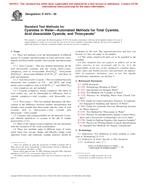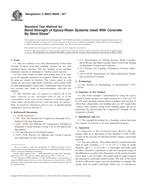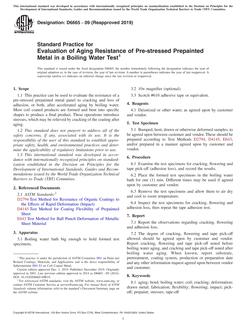1.1 These test methods cover the principles for establishing allowable mechanical properties for adhesives that can be used to design adhesive-bonded joints for structural components and assemblies of wood or wood with other materials. These test methods are modeled after Test Method D245.
1.2 The properties determined are allowable shear stress, allowable tensile stress, and allowable shear modulus.
1.3 In determination of allowable shear- and tensile-stress levels, these test methods are limited by the horizontal shear and tension perpendicular-to-the-grain capacity of the wood adherends (hard maple, Acer saccharum , Marsh.). The adhesives so tested may actually have shear or tensile allowable stresses exceeding the wood, but the determined allowable design stress levels are limited (upper bounded) by the wood in these test methods. If a wood other than hard maple is used for testing the adhesive, then the allowable strengths are upper bounded by the properties of that particular wood.
1.4 The strength properties are determined by standard ASTM test methods. As a result, only procedural variations from the standards and special directions for applying the results are given in these test methods.
1.5 Time-to-failure data derived from creep-rupture testing (see Test Method D4680) provide a measure of the ultimate strength of an adhesive bond as a function of time at various levels of temperature and moisture.
1.5.1 With proper caution, useful service life at a given shear stress level may be extrapolated from relatively short loading periods.
1.6 The resistance of the adhesive to permanent loss of properties due to aging (permanence) is assessed by means of strength tests after constant elevated-temperature and moisture aging of test specimens.
1.6.1 If the subject adhesives will be used to bond wood that has been treated with a preservative, fire retardant, or any other chemical to modify its properties, then the permanence of the adhesive shall be tested using wood adherends treated in the same manner.
1.7 Factors for durability, permanence, and creep derived by shear tests and analysis, are assumed to apply to tension (normal-to-the-bond) strength as well.
1.8 Requirements for production, inspection, and certification of adhesives evaluated under these test methods are not included.
1.9 This standard does not purport to address all of the safety concerns, if any, associated with its use. It is the responsibility of the user of this standard to establish appropriate safety and health practices and determine the applicability of regulatory limitations prior to use.
Product Details
- Published:
- 04/10/1999
- Number of Pages:
- 10
- File Size:
- 1 file , 130 KB


